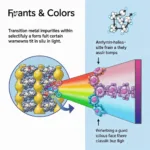Creating your own watercolor paints is a rewarding experience that allows you to explore a vast spectrum of colors and develop a deeper understanding of this versatile medium. Whether you’re a seasoned artist or just starting your creative journey, learning how to make water color paint opens up a world of possibilities, letting you tailor your palette to your unique artistic vision. From vibrant hues to subtle washes, homemade watercolors offer a unique level of control and customization that store-bought paints often lack.
After researching different pigments and binders, you can mix and match to create custom shades that perfectly suit your artistic style. It’s a fantastic way to experiment with color theory and discover new, exciting combinations. Plus, making your own paints can be a surprisingly cost-effective alternative to buying pre-made sets, especially if you use readily available materials. This guide will provide you with a step-by-step process for crafting your own vibrant watercolors.
If you are interested in other color techniques, you might want to know how to apply ion color brilliance.
Gathering Your Supplies for Watercolor Paint Making
Before embarking on your watercolor paint-making journey, gather the necessary tools and materials. This will ensure a smooth and efficient process. Having everything at hand will allow you to focus on the creative aspects of mixing colors and experimenting with different pigment combinations.
-
Pigments: These are the heart of your watercolors, providing the color. You can use dry pigment powders or grind down existing watercolor pans. Natural pigments from plants can be used if you are interested in what color is gamboge.
-
Binder: Gum arabic is the most common binder for watercolors, providing the necessary adhesion and consistency. Honey or glycerine can also be added to enhance the paint’s flow and prevent cracking.
-
Additives: Ox gall improves the paint’s flow and prevents it from beading on the paper. A preservative, such as honey, can be added to prevent mold growth.
-
Mixing Palette: A ceramic or glass palette is ideal for mixing your watercolors.
-
Muller: This tool is used to grind and disperse pigments evenly in the binder.
-
Small Jars or Pans: These are for storing your finished watercolors.
-
Distilled Water: This is essential for mixing your paints, as tap water can contain impurities that affect the paint’s quality.
 Essential supplies for making watercolor paint
Essential supplies for making watercolor paint
Mixing Your Watercolor Paints: A Step-by-Step Guide
Now that you have your supplies, let’s dive into the process of making your own watercolors.
-
Prepare the Pigment: If using dry pigment powder, measure out the desired amount. If using existing watercolors, grind them into a fine powder.
-
Mix the Binder: In a separate container, mix the gum arabic with distilled water until it reaches a honey-like consistency. You can explore different ratios of gum arabic to water to achieve varied consistencies, which will impact the final flow and texture of the paint.
-
Combine Pigment and Binder: Gradually add the pigment to the binder, mixing thoroughly with the muller to ensure even dispersion and prevent any clumps from forming. Work the muller in a circular motion, pressing down gently to grind the pigment into the binder.
-
Add Additives (Optional): If using additives like ox gall or honey, incorporate them into the mixture now. Mix well to ensure they are evenly distributed. Experimenting with the amount of ox gall will allow you to control the wettability and flow of your finished paint.
-
Adjust Consistency: Add more distilled water if needed to achieve your desired consistency. The paint should be thick enough to hold its shape but thin enough to flow smoothly from the brush. Achieving the correct consistency is crucial for the paint’s performance and how it interacts with the paper.
-
Store the Paint: Transfer the finished watercolor paint to small jars or pans. Allow the paint to dry completely before use. Proper storage is key to maintaining the quality and longevity of your homemade watercolors.
Thinking about colors for the summer season? Explore the vibrant possibilities of what is the color of summer.
Tips for Making Vibrant Watercolors
-
Pigment Quality: Invest in high-quality pigments for the best results. The quality of your pigments directly influences the vibrancy, lightfastness, and overall performance of your finished paints.
-
Mulling Thoroughly: Ensure that the pigment is thoroughly ground and dispersed in the binder to prevent a gritty texture. This step is crucial for creating smooth, even washes.
-
Experimentation: Don’t be afraid to experiment with different pigment combinations and binder ratios to discover unique and exciting colors. Creating your own watercolor paints offers an incredible opportunity for creative exploration.
Troubleshooting Common Issues
Sometimes, issues can arise when making watercolor paints. Here’s how to troubleshoot some common problems:
-
Gritty Texture: This indicates that the pigment wasn’t mulled sufficiently. Re-mull the paint until the grittiness disappears. If the paint is already dry, try re-wetting it and mulling again.
-
Mold Growth: If you notice mold growing on your paint, add a preservative like honey or a few drops of clove oil. Ensure proper storage in airtight containers to prevent future mold growth.
-
Poor Flow: If your paint isn’t flowing well, add a few drops of ox gall or glycerine to improve its wettability and flow characteristics.
Conclusion
Making your own water color paint is a deeply satisfying process that allows for unparalleled control and customization. By understanding the principles and techniques involved, you can create a unique palette of colors tailored to your artistic needs. Remember, experimentation is key. Don’t be afraid to explore different pigment combinations, binder ratios, and additives to discover new and exciting possibilities. Now that you’re equipped with the knowledge, start creating your own vibrant watercolors and unleash your creativity! For those looking for another color mixing adventure, you can check out how to make color olive green.
FAQ
-
What is the best binder for homemade watercolors? Gum arabic is the most widely used and recommended binder for watercolor paints due to its excellent binding properties and ability to create a smooth, even wash.
-
Can I use natural pigments to make watercolors? Yes, you can use natural pigments derived from plants, minerals, or other sources. However, be aware that the color intensity and lightfastness may vary compared to synthetic pigments.
-
How do I store homemade watercolor paints? Store your paints in airtight containers or pans to prevent them from drying out and to protect them from mold growth.
-
How can I make my watercolor paints more vibrant? Using high-quality pigments and ensuring thorough mulling will contribute to more vibrant colors.
-
What can I do if my paint is too thick? Add small amounts of distilled water until the desired consistency is reached.
Looking for a unique shade of blue? Find out what color is tidal.
For any assistance or inquiries regarding color and paint solutions, feel free to reach out to our expert team at Color Box Hà Nội. Contact us at 0373298888, email us at [email protected] or visit us at 86 Cầu Giấy, Hà Nội. Our customer service team is available 24/7 to provide you with personalized support and guidance. You might also find the answer to your questions in our other informative articles.

